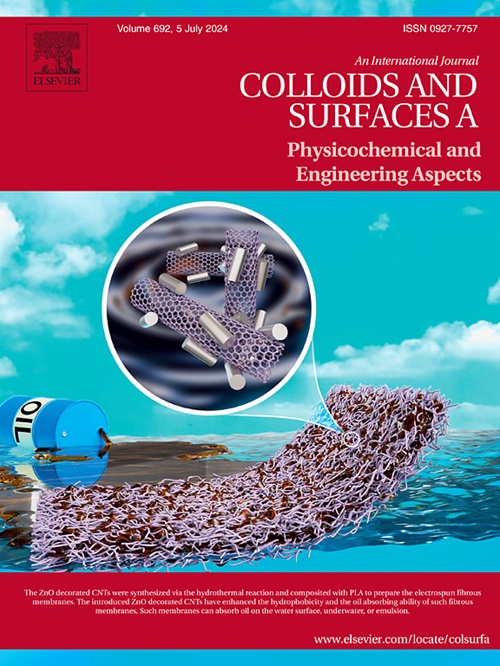Enhancing the thermal conductivity of Mg/diamond composites prepared by gas pressure infiltration through Zr coating and heat treatment
IF 4.9
2区 化学
Q2 CHEMISTRY, PHYSICAL
Colloids and Surfaces A: Physicochemical and Engineering Aspects
Pub Date : 2025-04-27
DOI:10.1016/j.colsurfa.2025.137060
引用次数: 0
Abstract
In the booming electronic information technology field, diamond-reinforced magnesium matrix composites (Mg/diamond composites) have attracted attention in the pursuit of high-performance thermal management materials. However, Mg/diamond composites suffer from low thermal conductivity. This is due to the fact that the interfacial reaction products between the diamond reinforcement and the Mg matrix are easily decomposed and Mg is highly reactive. In this study, we first coated a 150 nm Zr layer on diamond particles through a magnetron sputtering method. Subsequently, the Zr-coated diamond particles were heat-treated at different temperatures. Finally, the Mg/diamond-Zr composites were prepared through a gas pressure infiltration method. Furthermore, we analyzed the surface morphology of the Zr-coated diamond particles, as well as the microstructure and interfacial morphology of the composites using X-ray photoelectron spectroscopy (XPS), X-ray diffraction (XRD), scanning electron microscopy (SEM), and transmission electron microscopy (TEM) techniques. The results show that in the unheat-treated Mg/diamond-Zr composites, the interfacial bonding between the diamond reinforcement and the Mg matrix is weak. Through heat treatment, ZrC is formed at the Mg/diamond interface, strengthening the interfacial bonding. It was also found that the thickness of the ZrC layer increases with the heat-treatment temperature, and a suitable ZrC layer can enhance the thermal conductivity by bridging the acoustic impedance gap. Moreover, the thermal conductivity of the pristine Mg/diamond composites is only 67 W/mK. When there is a Zr coating on the diamond particles' surface, it increases to 159 W/mK, and it continues to rise with the heat treatment of the Zr-coated diamond particles. The thermal conductivity of the composites reaches a maximum value of 430 W/mK at 1150°C. These results will provide theoretical support for the application of Mg/diamond composites.
通过Zr涂层和热处理提高气压渗透制备的Mg/金刚石复合材料的导热性
在蓬勃发展的电子信息技术领域,金刚石增强镁基复合材料(Mg/金刚石复合材料)在追求高性能热管理材料方面备受关注。然而,Mg/金刚石复合材料的导热性较低。这是由于金刚石增强体与Mg基体之间的界面反应产物容易分解,Mg具有很强的反应性。在这项研究中,我们首先通过磁控溅射方法在金刚石颗粒上涂覆了150 nm的Zr层。随后,在不同温度下对zr包覆的金刚石颗粒进行热处理。最后,采用气压渗透法制备Mg/金刚石- zr复合材料。此外,我们还利用x射线光电子能谱(XPS)、x射线衍射(XRD)、扫描电子显微镜(SEM)和透射电子显微镜(TEM)等技术分析了zr包覆金刚石颗粒的表面形貌以及复合材料的微观结构和界面形貌。结果表明:在未经热处理的Mg/金刚石- zr复合材料中,金刚石增强体与Mg基体之间的界面结合较弱;通过热处理,在Mg/金刚石界面处形成ZrC,强化了界面结合。ZrC层厚度随热处理温度的增加而增加,合适的ZrC层可以通过桥接声阻抗间隙来提高导热系数。此外,原始Mg/金刚石复合材料的导热系数仅为67 W/mK。当金刚石颗粒表面有Zr涂层时,它增大到159 W/mK,随着涂层金刚石颗粒的热处理,它继续增大。复合材料的导热系数在1150℃时达到最大值430 W/mK。这些结果将为Mg/金刚石复合材料的应用提供理论支持。
本文章由计算机程序翻译,如有差异,请以英文原文为准。
求助全文
约1分钟内获得全文
求助全文
来源期刊
CiteScore
8.70
自引率
9.60%
发文量
2421
审稿时长
56 days
期刊介绍:
Colloids and Surfaces A: Physicochemical and Engineering Aspects is an international journal devoted to the science underlying applications of colloids and interfacial phenomena.
The journal aims at publishing high quality research papers featuring new materials or new insights into the role of colloid and interface science in (for example) food, energy, minerals processing, pharmaceuticals or the environment.

 求助内容:
求助内容: 应助结果提醒方式:
应助结果提醒方式:


